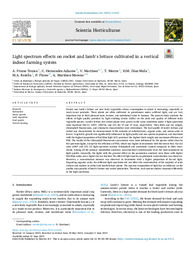Please use this identifier to cite or link to this item:
https://hdl.handle.net/11000/32441Full metadata record
| DC Field | Value | Language |
|---|---|---|
| dc.contributor.author | Frutos-Totosa, A. | - |
| dc.contributor.author | Hernández-Adasme, C. | - |
| dc.contributor.author | Martínez, V. | - |
| dc.contributor.author | Mestre, T. | - |
| dc.contributor.author | Diaz-Mula, Huertas Maria | - |
| dc.contributor.author | Botella, M. Ángeles | - |
| dc.contributor.author | Flores, Pilar | - |
| dc.contributor.author | Martínez Moreno, A. | - |
| dc.contributor.other | Departamentos de la UMH::Biología Aplicada | es_ES |
| dc.date.accessioned | 2024-07-12T08:32:24Z | - |
| dc.date.available | 2024-07-12T08:32:24Z | - |
| dc.date.created | 2023-11-01 | - |
| dc.identifier.citation | Scientia Horticulturae, Volume 321, 1 November 2023, 112221 | es_ES |
| dc.identifier.issn | 1879-1018 | - |
| dc.identifier.issn | 0304-4238 | - |
| dc.identifier.uri | https://hdl.handle.net/11000/32441 | - |
| dc.description.abstract | Rocket and lamb’s lettuce are new leafy vegetables whose consumption in salads is increasing, especially as ready-to-eat products. These plants are often cultivated in greenhouses under artificial light, and are very important due to their pleasant taste, texture, and nutritional value to humans. The present study analyzes the effects of light quality provided by light emitting diodes (LEDs) on the yield and quality of different leafy vegetable species. Lamb’s lettuce and rocket plants were grown in the same conditions under 4 light spectrums color fractions (NS-12, AP57, AP673L, and G2) for 27 and 37 days, respectively. Then fresh and dry weight, chlorophyll fluorescence, and chromatic characteristics were determined. The leaf quality of lamb’s lettuce and rocket was characterized by measurements of the contents of carbohydrates, organic acids, and amino acids in leaves. Vegetative growth was significantly influenced by light quality and was species-dependent, and treatment with the highest proportion of Red:Blue light (G2) produced the highest fresh weight and maximum efficiency of PSII. The results of the chlorophyll fluorescence parameters were more influenced by the species rather than by the spectrum lights, except for the efficiency of PSII, which was higher in treatments with the lowest Red: Far-red ratio (AP67 and G2). G2 light spectrum reduces chlorophyll and carotenoid content compared to other treatments. Among all the primary metabolites analyzed, non-structural carbohydrates were the most dependent on light quality. Generally, the lights with the greatest effect on the parameters analyzed were those with higher Red:Blue ratios and a higher far-red fraction. No effect of light spectra on glutamate concentration was observed. However, a concentration increase was observed in treatments with a higher proportion of far-red light. Regarding organics acids, the different light spectrums did not affect the concentration of the majority of acids (citrate and malate) in rocket and lamb´s lettuce plants. The spectral composition of light has an influence on the quality and quantity of lamb’s lettuce and rocket production. Therefore, each species studied responds differently to the light spectrums. | es_ES |
| dc.format | application/pdf | es_ES |
| dc.format.extent | 9 | es_ES |
| dc.language.iso | eng | es_ES |
| dc.publisher | Elsevier | es_ES |
| dc.rights | info:eu-repo/semantics/openAccess | es_ES |
| dc.rights | Attribution-NonCommercial-NoDerivatives 4.0 Internacional | * |
| dc.rights.uri | http://creativecommons.org/licenses/by-nc-nd/4.0/ | * |
| dc.subject | Hydroponic | es_ES |
| dc.subject | Indoor growth | es_ES |
| dc.subject | Leafy vegetables | es_ES |
| dc.subject | Food quality | es_ES |
| dc.subject | Vertical farming | es_ES |
| dc.subject.other | CDU::5 - Ciencias puras y naturales::57 - Biología | es_ES |
| dc.title | Light spectrum effects on rocket and lamb’s lettuce cultivated in a vertical indoor farming system | es_ES |
| dc.type | info:eu-repo/semantics/article | es_ES |
| dc.relation.publisherversion | https://doi.org/10.1016/j.scienta.2023.112221 | es_ES |

View/Open:
1-s2.0-S0304423823003928-main.pdf
570,37 kB
Adobe PDF
Share:
.png)
